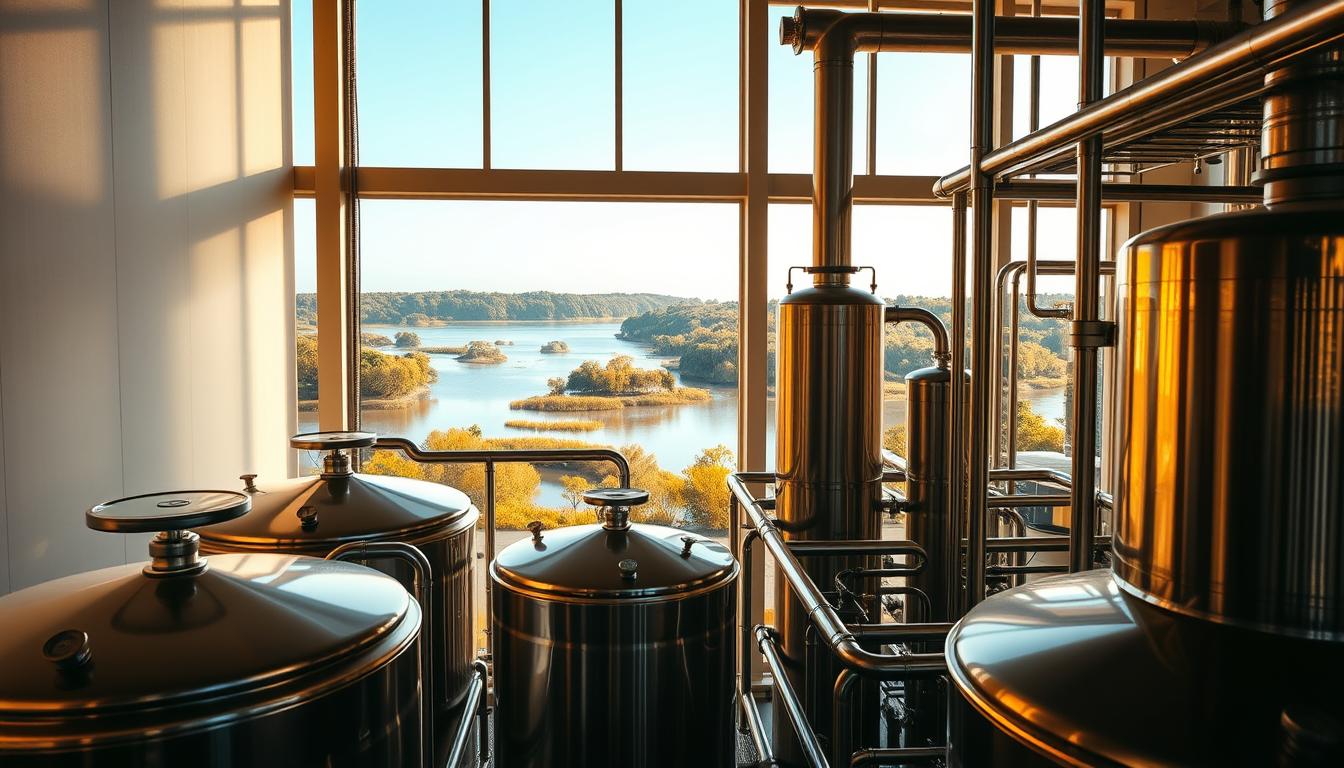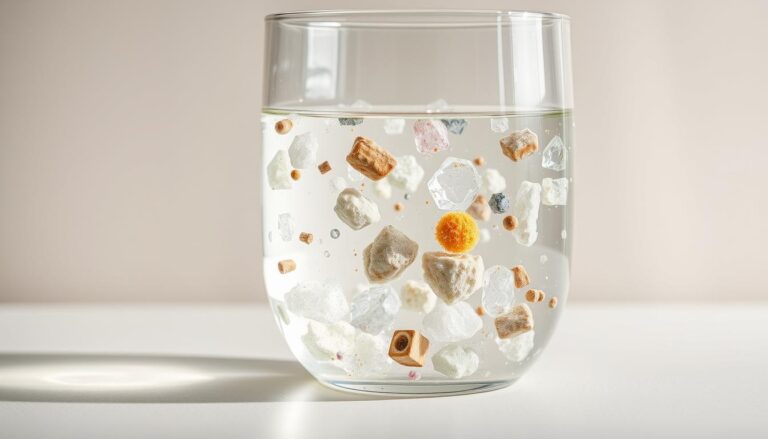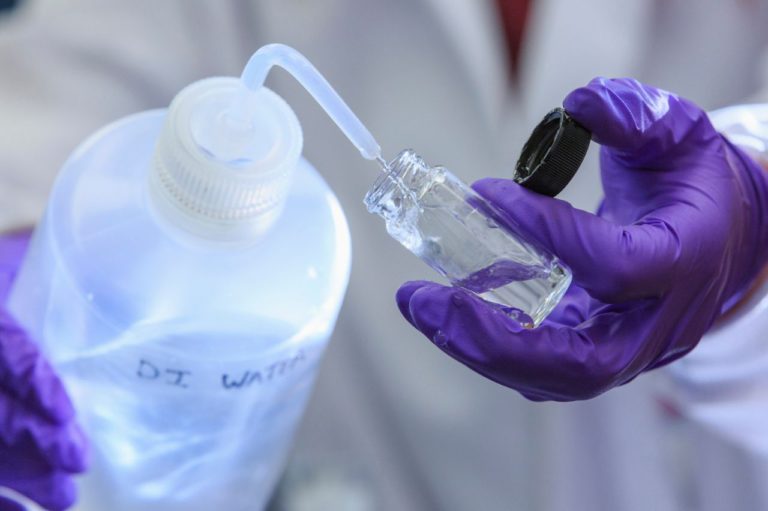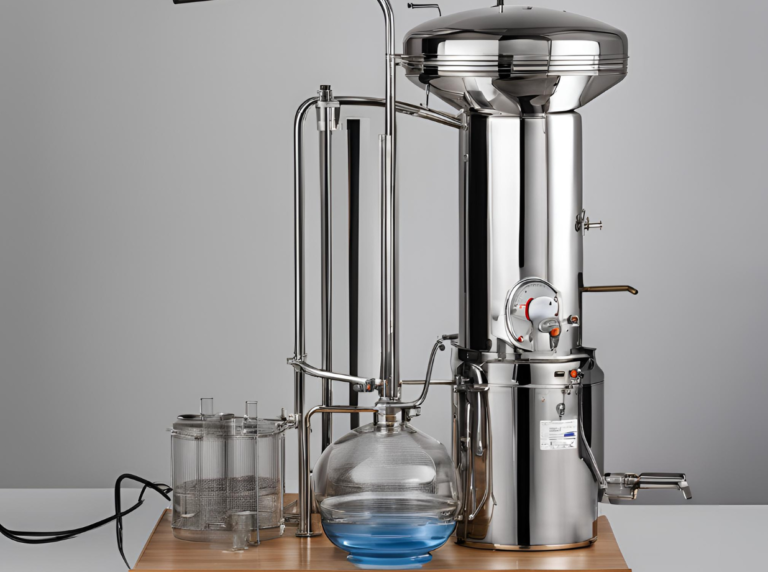How Much Water Does It Take to Make Distilled Water?
Have you ever stopped to think about the process of producing distilled water? It’s a question that might seem simple, but the answer is quite complex. Distilled water production involves a fascinating process that requires a significant amount of water.
To understand the intricacies of distilled water production, let’s consider the basics. Distilled water is produced by vaporizing water and then condensing it back into a liquid state, free from many contaminants. But what is the actual water consumption for this process?
The process of distillation is not as straightforward as it seems, and the amount of water needed to produce a gallon of distilled water is often a topic of debate.
Key Takeaways
- Distilled water production involves a complex process.
- The amount of water needed for distillation is significant.
- Understanding the process can help clarify the water consumption.
- Distilled water is free from many contaminants.
- The production process involves vaporization and condensation.
Understanding Distilled Water
The concept of distilled water revolves around its purity, achieved through a meticulous process of distillation. Distilled water is used in various contexts where high purity is essential.
What Is Distilled Water?
Distilled water is a type of purified water that has been treated to remove impurities and minerals. This process involves boiling the water and then condensing the steam back into liquid form, leaving many contaminants behind.
The Purity Factor
The purity of distilled water is one of its defining characteristics. With most impurities removed, it is ideal for applications where mineral-free water is necessary.
Chemical Composition
The chemical composition of distilled water is primarily H2O, with very low levels of other substances. This makes it suitable for sensitive applications.
Common Uses for Distilled Water
Distilled water has a wide range of applications across different sectors. Its purity makes it suitable for medical, laboratory, household, and industrial uses.
Medical and Laboratory Applications
In medical and laboratory settings, distilled water is used for procedures requiring high purity water, such as in autoclaves and for preparing medical solutions.
Household and Industrial Uses
For households, distilled water can be used in steam irons and humidifiers to prevent mineral buildup. Industrially, it’s used in manufacturing processes and for cooling systems.
The Distillation Process Explained
Understanding how distillation works is crucial for appreciating the effort that goes into making distilled water. Distillation is a purification method that involves the conversion of water from liquid to vapor and back to liquid, effectively removing impurities.
Basic Principles of Distillation
Distillation operates on the principle that water and its impurities have different boiling points. When water is heated, it evaporates, leaving behind many contaminants.
Heating and Evaporation
The process begins with heating the water until it reaches its boiling point, turning it into vapor. This step is crucial as it ensures that the water is separated from many of its impurities.
Condensation and Collection
As the vapor rises, it cools down in a condenser, converting back into liquid water, now free from many contaminants. This distilled water is then collected.
Types of Distillation Methods
There are several methods of distillation, each with its own applications and efficiencies.
Simple Distillation
Simple distillation involves a single cycle of evaporation and condensation. It’s effective for removing many impurities but may not eliminate all contaminants.
Fractional Distillation
Fractional distillation is a more complex process that involves multiple cycles of distillation, allowing for a more thorough purification of the water.
The choice between simple and fractional distillation depends on the desired purity of the distilled water and the equipment available.
| Distillation Method | Purity Level | Equipment Complexity |
|---|---|---|
| Simple Distillation | Moderate | Low |
| Fractional Distillation | High | High |
How Much Water Does It Take to Make a Gallon of Distilled Water?
To determine how much water it takes to make a gallon of distilled water, we need to consider both the theoretical and practical aspects of distillation.
The Basic Water Ratio
The basic water ratio in distillation refers to the amount of water required to produce a certain quantity of distilled water. This ratio is crucial for understanding the efficiency of the distillation process.
Theoretical Yield
The theoretical yield is the maximum amount of distilled water that can be produced from a given quantity of input water, assuming 100% efficiency. In theory, if we had a perfectly efficient distillation system, the yield would be directly related to the input water quantity.
Practical Yield
Practical yield, on the other hand, takes into account the real-world inefficiencies of the distillation process. Factors such as equipment design, operational variables, and energy losses affect the actual yield. For instance, a typical distillation system might have a practical yield of 80-90% due to these inefficiencies.
Efficiency Factors in Distillation
The efficiency of a distillation system is influenced by several factors, including system design and operational variables.
System Design Impact
The design of the distillation system plays a significant role in its efficiency. For example, a well-designed condenser can significantly reduce water loss during the condensation process.
Operational Variables
Operational variables such as temperature, pressure, and flow rate also impact the efficiency of the distillation process. Optimizing these variables can help minimize water loss and maximize the yield of distilled water.
| Distillation System | Theoretical Yield (%) | Practical Yield (%) |
|---|---|---|
| Basic Distillation | 100 | 80 |
| Advanced Distillation | 100 | 90 |
| Commercial Distillation | 100 | 95 |
By understanding these factors and optimizing the distillation process, we can reduce the amount of water needed to produce a gallon of distilled water.
Water Loss During Distillation
Understanding water loss during distillation is crucial for optimizing the process. Distillation, a common method for purifying water, involves the conversion of water into vapor and its subsequent condensation back into liquid form. However, this process is not entirely efficient, leading to significant water loss.
Evaporation and Condensation Efficiency
The efficiency of evaporation and condensation plays a critical role in determining the overall water loss during distillation. Several factors contribute to inefficiencies in these processes.
Heat Transfer Losses
One major factor is heat transfer losses. During distillation, heat is used to vaporize water. However, not all the heat is effectively used; some is lost to the surroundings, reducing the efficiency of the process. Improving insulation and optimizing the design of distillation equipment can help minimize these losses.
Vapor Escape Points
Another significant factor is vapor escape points. If the distillation apparatus is not properly sealed, vapor can escape, leading to water loss. Ensuring that all connections are tight and using appropriate sealing techniques can mitigate this issue.
Measuring Water Loss in Different Systems
Water loss during distillation can vary significantly depending on the type of distillation system used. Different systems have different efficiencies and loss mechanisms.
Home Distillers
Home distillers often have simpler designs and may not be as efficient as commercial systems. They can still be effective for small-scale water purification but may suffer from higher water loss due to less sophisticated condensation and evaporation mechanisms.
Commercial Equipment
Commercial distillation equipment, on the other hand, is designed for large-scale production and typically incorporates more advanced technologies to minimize water loss. These systems often include sophisticated condensation systems and better insulation to reduce heat transfer losses.
Home Distillation vs. Commercial Production
The process of distilling water varies significantly between home and commercial settings, impacting water consumption. While both methods aim to produce pure distilled water, the scale and efficiency of the process differ substantially.
Water Usage in Home Distillers
Home distillers, including countertop units and DIY systems, are designed for personal use. They typically have smaller capacities and varying levels of efficiency.
Countertop Units Efficiency
Countertop distillers are convenient for home use, with capacities usually ranging from 1 to 4 gallons. Their efficiency can vary, but most models consume between 1 to 3 kilowatt-hours (kWh) of electricity per gallon of distilled water produced. According to a study, “countertop distillers can achieve an efficiency of around 20-30% in terms of water recovery”
“The efficiency of countertop distillers is a crucial factor for households looking to produce distilled water at home.”
.
DIY Distillation Systems
DIY distillation systems offer a cost-effective alternative for home users. These systems can be more variable in terms of efficiency, as they depend on the materials and design used. However, they can be optimized for better water usage.
Industrial Distillation Water Efficiency
Commercial or industrial distillation systems are designed for large-scale production. They incorporate advanced technologies to maximize efficiency and minimize water waste.
Large-Scale Operations
Large-scale commercial distillers use significant amounts of water but are designed to be more efficient on a per-gallon basis. They often employ advanced recirculation and heat recovery systems.
Recirculation Systems
Recirculation systems in commercial distillation operations play a crucial role in enhancing water efficiency. By reusing water that would otherwise be wasted, these systems can significantly reduce overall water consumption. As noted, “recirculation systems can improve water efficiency by up to 50% in some distillation processes.”
In conclusion, while both home and commercial distillation have their efficiencies and inefficiencies, understanding the differences is key to optimizing water usage. By adopting more efficient distillation methods, whether at home or in commercial settings, we can reduce the overall water consumption associated with producing distilled water.
Factors Affecting Water Consumption in Distillation
The amount of water required to produce distilled water varies significantly based on several key factors. Understanding these factors is crucial for optimizing the distillation process and reducing water consumption.
Equipment Quality and Design
The quality and design of the distillation equipment play a significant role in determining water consumption. High-quality distillers with efficient designs can minimize water loss and reduce the amount of water needed for cooling. For instance, some modern distillers use a counter-current heat exchange system to pre-heat the incoming water, thereby reducing the energy required and the water needed for cooling.
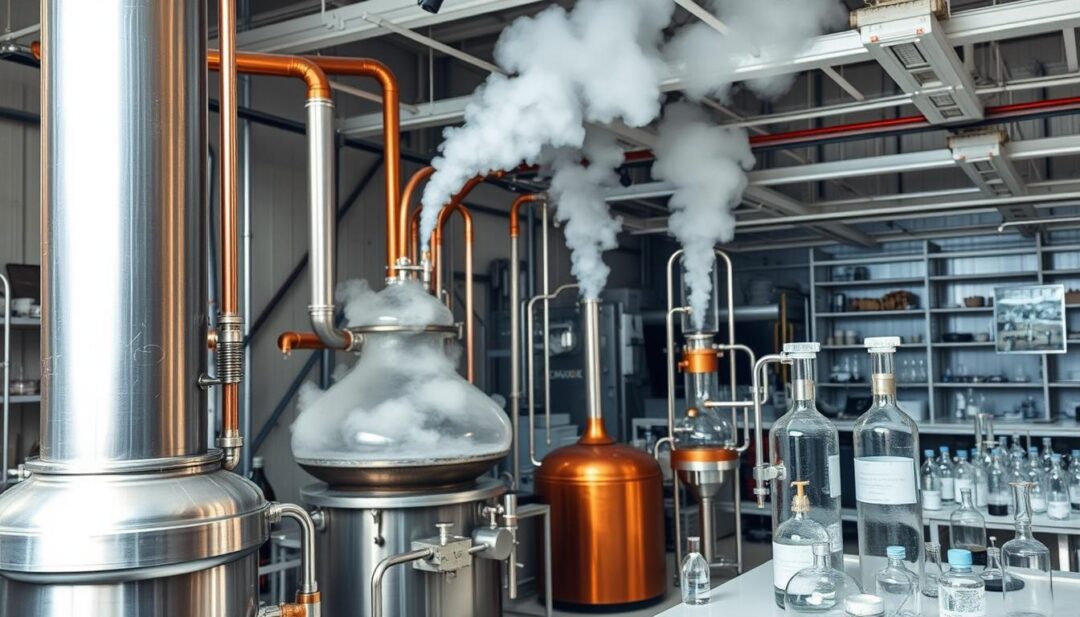
Temperature and Pressure Considerations
Operational conditions such as temperature and pressure also significantly impact water consumption in distillation. Operating at optimal temperatures can enhance the efficiency of the distillation process, reducing the amount of water lost to evaporation. Similarly, maintaining the right pressure is crucial for efficient condensation and minimizing water loss.
Source Water Quality
The quality of the source water is another critical factor that affects water consumption in distillation. The presence of minerals and other contaminants can influence the efficiency of the distillation process.
Mineral Content Impact
Water with high mineral content can lead to scaling in the distillation equipment, reducing its efficiency and increasing water consumption. Regular maintenance and descaling are necessary to mitigate this issue.
Pre-treatment Requirements
Pre-treating the source water to remove contaminants and minerals can significantly improve the efficiency of the distillation process. Techniques such as reverse osmosis or activated carbon filtration can be used to pre-treat the water, reducing the load on the distillation equipment and minimizing water consumption.
By understanding and addressing these factors, it’s possible to optimize the distillation process, reduce water consumption, and produce high-quality distilled water more efficiently.
Environmental Impact of Distilled Water Production
Understanding the environmental footprint of distilled water is crucial for assessing its overall sustainability. The production of distilled water involves more than just boiling and condensing water; it encompasses a range of processes that can have significant environmental implications.
Water Footprint Analysis
The water footprint of distilled water production includes both direct and indirect water usage. Direct water usage refers to the water that is actually distilled, while indirect water consumption involves the water used in the energy production required to power the distillation process.
Direct Water Usage
Direct water usage in distillation is straightforward; it’s the amount of water that is fed into the distillation apparatus. However, not all of this water is recovered as distilled water; some is lost as waste heat or through other inefficiencies.
Indirect Water Consumption
Indirect water consumption, often referred to as “virtual water,” is associated with the energy required to operate distillation equipment. The production of energy, especially from non-renewable sources, has its own water footprint, which must be considered when evaluating the overall environmental impact of distilled water.
Sustainable Distillation Practices
To mitigate the environmental impact of distilled water production, several sustainable practices can be adopted. These include the use of energy-efficient systems and water recovery techniques.
Energy-Efficient Systems
Modern distillation systems can be designed to be highly energy-efficient, reducing both the direct and indirect environmental impacts. For example, using renewable energy sources or optimizing the distillation process to minimize energy consumption.
Water Recovery Techniques
Implementing water recovery techniques can significantly reduce waste and improve the overall efficiency of the distillation process. This can involve reusing the water that would otherwise be discarded or implementing systems that minimize water loss.
| Sustainable Practice | Environmental Benefit |
|---|---|
| Energy-Efficient Systems | Reduces energy consumption and associated water footprint |
| Water Recovery Techniques | Minimizes water waste and improves overall efficiency |
Comparing Distillation with Other Purification Methods
The quest for clean drinking water has led to the development of various purification methods, including distillation, reverse osmosis, and filtration. Understanding the differences between these methods is crucial for selecting the most appropriate one for specific needs.
Water Usage: Distillation vs. Reverse Osmosis
Distillation and reverse osmosis are both effective water purification methods, but they differ significantly in their approach and water usage. Distillation involves boiling water and then condensing the steam to produce purified water, whereas reverse osmosis uses a semi-permeable membrane to filter out impurities.
Efficiency Comparison
Reverse osmosis is generally more water-efficient than distillation, as it doesn’t involve heating water. Studies have shown that reverse osmosis can be up to three times more efficient in terms of water usage compared to distillation.
“Reverse osmosis is a more energy-efficient and cost-effective method for purifying water compared to distillation.” –
Quality Differences
The quality of water produced by distillation and reverse osmosis can vary. Distillation is effective in removing a wide range of contaminants, including bacteria, viruses, and heavy metals. Reverse osmosis also removes many impurities but may not be as effective against certain dissolved gases.
| Purification Method | Water Usage Efficiency | Purification Effectiveness |
|---|---|---|
| Distillation | Low | High |
| Reverse Osmosis | High | High |
Water Usage: Distillation vs. Filtration
Filtration is another common method of water purification, which involves passing water through a filter to remove impurities. The comparison between distillation and filtration reveals different strengths and weaknesses.
Resource Requirements
Filtration generally requires less energy than distillation, as it doesn’t involve heating water. However, the effectiveness of filtration depends on the type of filter used.
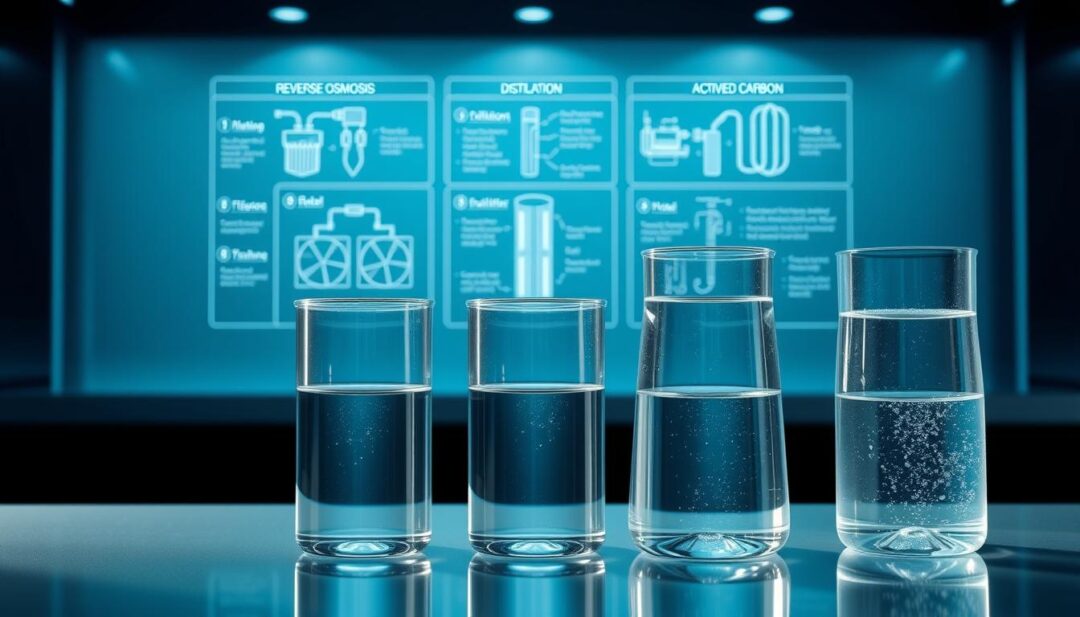
Distillation is highly effective in removing a broad spectrum of contaminants, including dissolved solids. Filtration can be effective against particulate matter and some microorganisms, depending on the filter’s pore size.
In conclusion, the choice between distillation, reverse osmosis, and filtration depends on specific needs and priorities, including water usage, efficiency, and the desired quality of purified water.
Practical Tips for Efficient Distilled Water Production
To produce distilled water efficiently, it’s crucial to optimize your distillation setup. This involves several key considerations, from the initial equipment selection to ongoing maintenance practices.
Optimizing Your Distillation Setup
A well-optimized distillation setup is fundamental to efficient distilled water production. Two critical aspects of this setup are equipment selection and maintenance practices.
Equipment Selection
Choosing the right equipment is the first step towards efficient distillation. Consider the following:
- Select a distiller that matches your production needs.
- Look for energy-efficient models to reduce operational costs.
- Ensure the equipment is durable and easy to maintain.
Maintenance Practices
Regular maintenance is essential to keep your distillation system running efficiently. Key practices include:
- Regularly clean and descale the distiller to prevent mineral buildup.
- Check and replace worn-out parts to maintain optimal performance.
- Monitor the system’s performance regularly to catch any issues early.
Reusing and Recycling Water
Reusing and recycling water can significantly enhance the efficiency of your distilled water production. This can be achieved through cooling water recovery and utilizing waste streams effectively.
Cooling Water Recovery
Cooling water recovery involves reusing the water used in the cooling process. This can be done by:
- Implementing a closed-loop cooling system.
- Using the recovered water for other processes or non-potable purposes.
Waste Stream Applications
Waste streams from the distillation process can often be repurposed. Consider the following applications:
- Using the waste heat for other heating needs.
- Applying the concentrated waste stream to appropriate industrial processes.
Conclusion
The process of making distilled water involves understanding the intricacies of distillation and the factors that influence its efficiency. Historically, it took one gallon of fuel to make one gallon of fresh water using pre-World War II methods. However, advancements in technology have significantly improved this ratio.
The Kleinschmidt still is a notable example, capable of producing 175 US gallons of fresh water from every gallon of fuel. This highlights the progress made in distillation efficiency. For a comprehensive understanding of distilled water production, it’s essential to consider the various methods and their respective efficiencies.
To learn more about the distillation process and its applications, you can refer to the Wikipedia article on Distilled water. This resource provides a detailed overview of the subject, supporting the distilled water production summary.
In conclusion, the amount of water it takes to make distilled water varies significantly depending on the distillation method used. By understanding these factors, individuals and industries can optimize their water production processes, leading to more efficient use of this vital resource.

